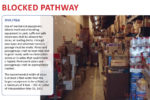Upton Sinclair’s The Jungle was published in 1906, sparking a public outcry around safety issues in the meatpacking industry. That’s how long the industry has been infamous for its hazardous working conditions.
The good news is, according to new reports from the Bureau of Labor Statistics (BLS), workplace safety in the meatpacking industry is steadily improving, with injury and illness rates for full-time workers on the decline.
The bad news is, in comparison to other industrial and manufacturing sectors, meatpacking and poultry processing are still among the most dangerous. Food manufacturing workers are twice as likely to experience injuries and illnesses than industrial and manufacturing workers as a whole. The meatpacking industry also ranks high for severe injury and illness cases – meaning those that cause workers to miss days at work or those that necessitate restricted work activities or even job transfers. Nationally, the poultry industry has the fifth-highest rate of worker illness across all industries.
Though progress has been made on worker safety in the meatpacking and poultry industries, we must understand what the numbers really mean, and make sure we are addressing issues that really make a difference in improving safety and health in these industries.
Some in the meat industry, like the trade association (read: lobbying outfit) American Meat Institute, are quick to highlight improvement using data that does not reflect the most dangerous jobs in the industry. That’s a slippery slope – and one that risks obscuring the truth on safety for the sake of profit-margin. The truth is, there is some doubt about the accuracy of the BLS numbers themselves. Studies conducted by the National Institute of Occupational Safety and Health (NIOSH) conclude that both BLS and OSHA miss from 20 percent to as much as 50 percent of the nation’s workplace injuries. A number of factors can cause this kind of under-reporting: workers sometimes don’t report injuries because of fears surrounding their immigration status and retaliation by their employers; employers are motivated to under-count injuries in order to win safety awards, and managers are incentivized by low-injury bonuses; and finally, some employers have instituted programs requiring workers who report injuries or accidents to undergo drug testing – adding additional risk to reporting.
For all these reasons, we must not let a modest increase in overall workplace safety lull us into a false sense of security when it comes to the meatpacking and poultry processing industries. We must continue to strive for better and safer workplaces for all meatpacking and poultry processing workers – and for collective bargaining agreements as well as stronger regulations that make it safe for all workers to report hazards and injuries.

